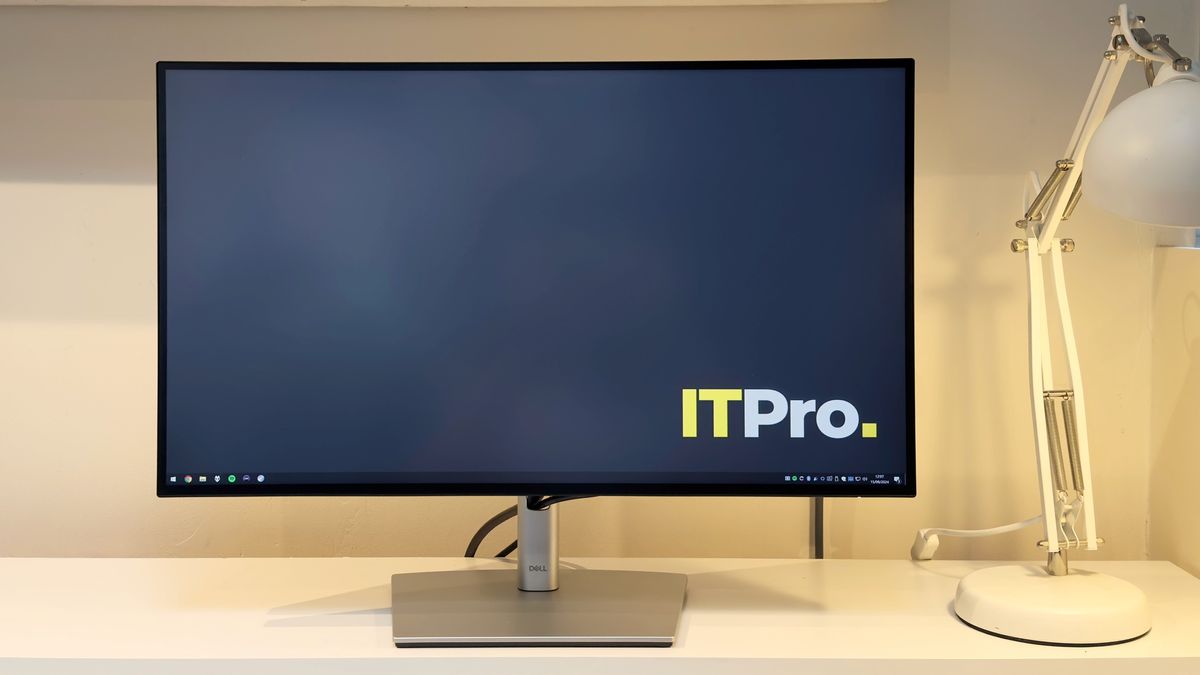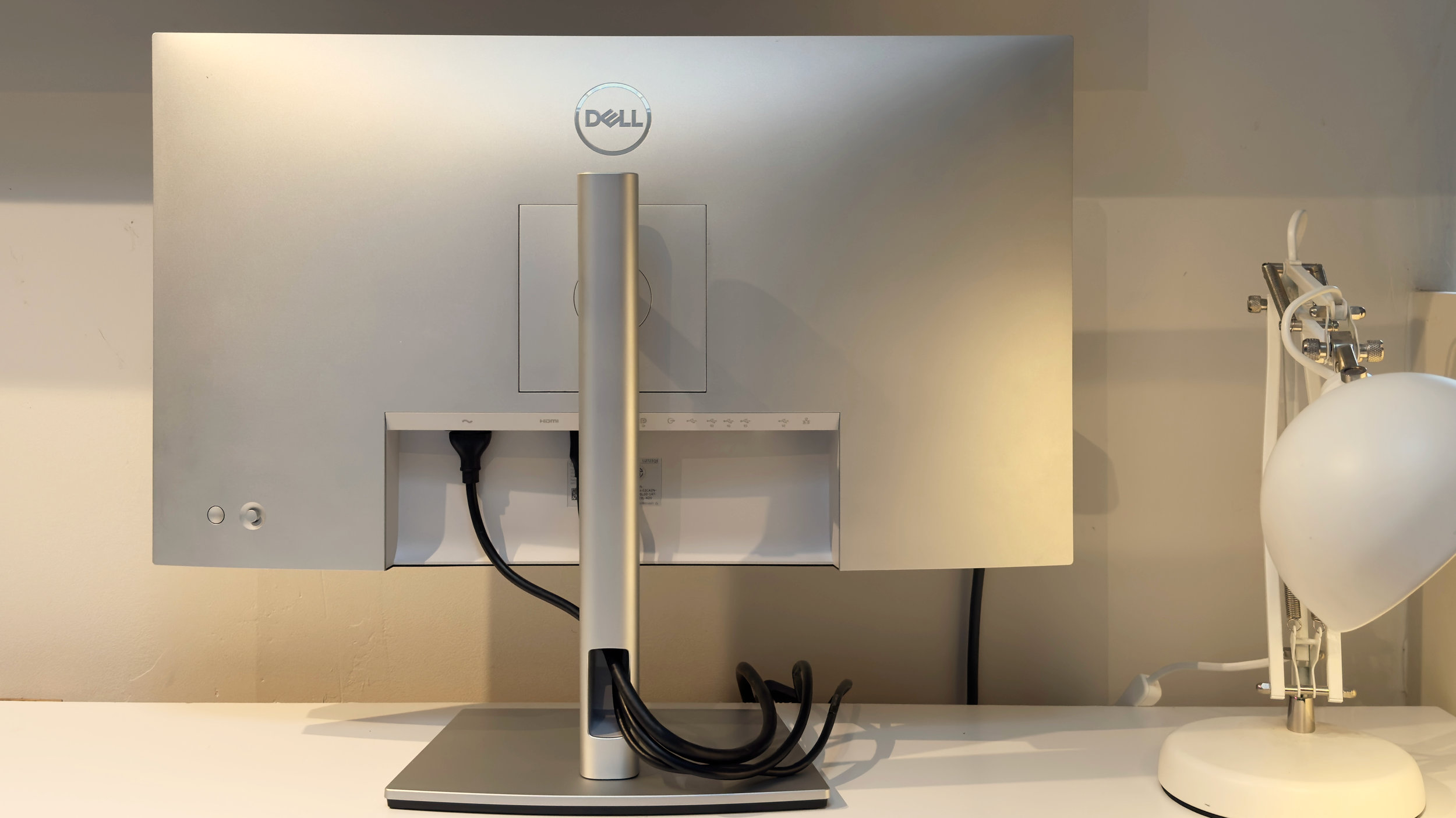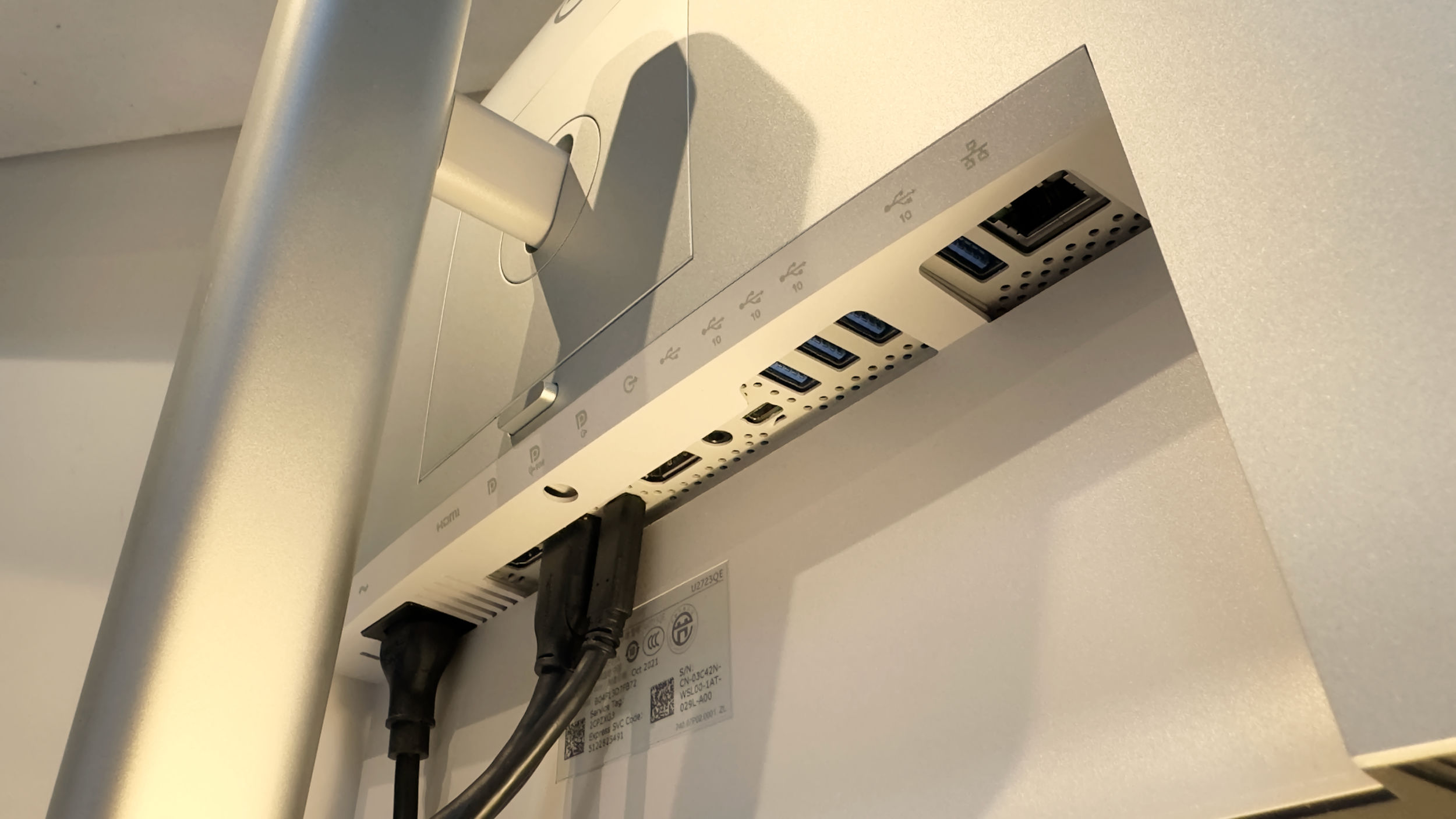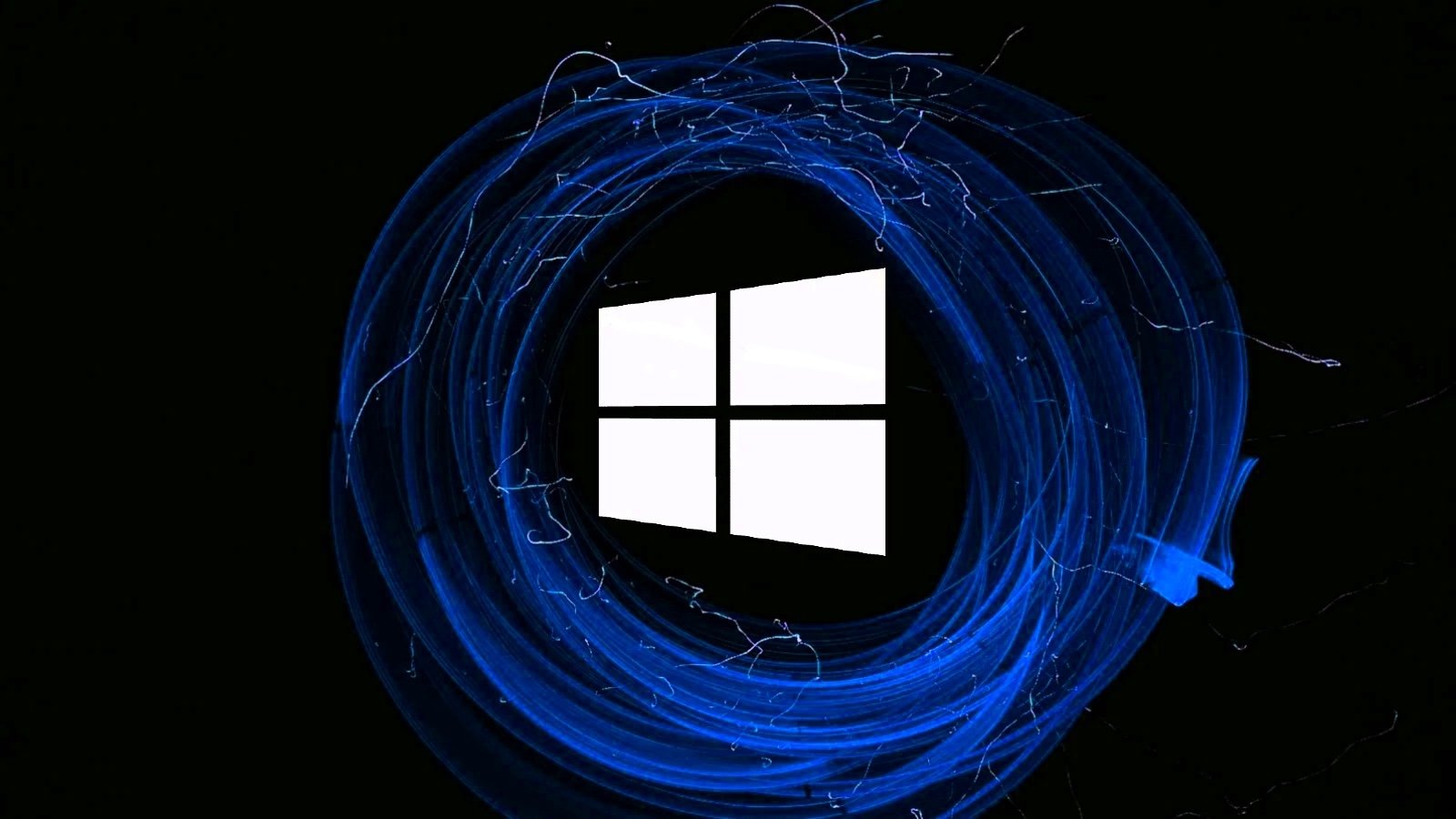Dell UltraSharp U2723QE monitor review

While some of us dream of TV-sized monitors on our desks, the reality of the modern office is that space is often at a premium. That’s why monitors such as Dell’s U2723QE are such an appealing prospect. This smart 27in monitor packs in a 4K IPS panel, color-accurate performance, an adjustable stand, a five-port USB-C hub with 90W charging, and KVM functionality for under £500. Intrigued? We certainly were.
Monitors with a 4K resolution aren’t newsworthy these days, but there are benefits to squeezing 8 million plus pixels into a modest 27in diagonal, and especially so for office use. Text is crystal clear – dramatically more so than similarly sized 1440P monitors – and when that clarity goes hand-in-hand with superb color accuracy, you have a recipe for productivity nirvana.
On that front, Dell’s decision to employ a high-quality IPS Black panel both boosts contrast and provides good color accuracy in both sRGB and Display P3 modes. For professionals who prize image quality as highly as business-friendly features, the Dell is an easy sell.
There are some slightly finicky aspects – some USB-C-equipped laptops and desktops may have to pick between a 60Hz refresh rate and maximal USB 3.2 data speeds via the built-in hub, something which we’ll discuss in more detail later – but overall it’s hard to be too critical at the price. Suffice it to say, the U2723QE does an awful lot right for the money.
Dell UltraSharp U2723QE monitor: Design and features
From the moment you start unpacking the Dell, it’s clearly a cut above your average 27in monitor. The slender stand clicks and screws into place in seconds – there are no tools or screwdrivers required – and the solidity of the build immediately feels like a step up from cheaper rivals.
That sturdy-feeling stand does almost everything you could ask of it, too, providing 150mm of height adjustment alongside tilt, swivel, and rotation into portrait mode. There are some minor niggles, though. For instance, while it is possible to adjust the height one-handed without the base lifting up, tilting the monitor backward or forwards is a two-handed job – the base rocks back and forth as the tilt mechanism is just a tad too stiff. The rather rough, rumbly feel to the height adjustment is another nitpick; it doesn’t slide smoothly up and down like the best we’ve encountered.
Still, it’s hard not to appreciate the overall design. The neat little angled cut-out at the base of the U2723QE’s stand allows you to slot cables through quickly and easily, gathering them neatly to the rear, and this neatness goes hand in hand with a smart two-tone silver and black design which looks pretty slick from any angle. It’s a really tiny thing, but we also appreciated the fact that the stand doesn’t protrude very far beyond the panel’s bottom edge: you can push your keyboard right back up to the base’s flat edge when you’re not using it, and reclaim some precious desk space.
Connectivity is impressively well-rounded. You get HDMI 1.4 and DisplayPort 1.4 inputs, both of which are HDCP 2.2-compliant, alongside a USB-C input at the rear which receives 4K 60hz signals and provides up to 90W of power via USB-PD. A second upstream USB-C port and DisplayPort output are both masked off with orange rubber bungs – you can use these ports to take advantage of the Dell’s KVM functions and/or daisy chain a second monitor. There’s also a gigabit Ethernet socket for good measure and this is shared to any connected computer – albeit only one at a time – via the USB connection.
The in-built USB hub is generously appointed: there are four USB-A 3.2 Gen 2 ports at the rear supplemented by a further two – a single USB-C and single USB-A port – positioned just underneath the monitor’s bottom-left-hand corner. All six of these ports only supply 15W of power, though, so while you can charge a device from any of them, it’ll be at a reduced rate.
It’s good to find some cables in the box – a 1.8m DisplayPort cable, a super-speed USB-A to USB-C cable, and a plain 1m USB-C cable – but it’s a shame Dell couldn’t stretch to an HDMI cable, too. It’s also a tad shortsighted to only provide a 1m USB-C cable; a 1.8m cable would have provided more flexibility.
And much as we love the simplicity of USB-C, the U2723QE’s implementation isn’t quite plug and play: it requires the user to pick between two modes, High Resolution or High Data Speed. Activate High Resolution mode and the USB-C cable passes uncompressed 4K 60Hz images but limits data transfers to USB 2.0 speeds. Switch to High Data Speed mode and you’ll get full-speed 10mbit USB 3.2 transfers, but DisplayPort 1.2 devices are limited to 4K 30Hz images while DisplayPort 1.4 devices with support for Display Stream Compression (DSC) get compressed 4K 60Hz images. It’s also worth noting that you’ll need to use High-Resolution mode while daisy-chaining a second monitor from the U2723QE if you want 4K 60Hz signals across both displays.

The Dell’s KVM features are a nice bonus. This means you can also connect a second PC or laptop to the U2723QE and share one set of peripherals and any other devices connected to the monitor’s USB ports without constantly needing to swap cables. We’d think twice before using it to share an Ethernet connection, though, as it only provides a wired network connection to one computer at a time – you may be better off buying a basic Ethernet switch for this purpose.
If you are tempted to make use of Dell’s KVM functions, make sure to install Dell’s Display Manager software, as this lets you set up a hotkey to switch from one computer to the other, and set up the monitor’s Picture in Picture (PiP) and Picture by Picture (PbP) functions. While it is possible to swap between machines and activate PbP or PiP via the monitor’s OSD and four-way rocker at the back of the monitor, it’s not something we’d recommend – it’s very fiddly and slow.
Dell UltraSharp U2723QE monitor: Display quality
Even at its default settings, the Dell serves up some gorgeous images. Peak brightness hits a sensible middle ground of 170cd/m2 – a bit bright for artificial office lighting, but probably about right for offices with more natural light – and the overall color accuracy is excellent, with the monitor producing faithful colors and natural-looking skintones.
The monitor defaults to the DCI-P3 color space out of the box, and the measurements are very respectable. The average Delta E of 1.48 indicates that colors are accurate enough for color-critical work, and the U2723QE only exceeded a Delta E of 2 in the more saturated red part of the spectrum, where the Delta E peaked at 3.48. Color temperature is very slightly cool at 6,595k, but it’s not far off the ideal of 6,500k.
Dab the four-way joystick on the rear, however, and it’s quick and easy to flick the display into sRGB mode. That done, the color accuracy improves dramatically, with the average Delta E dropping to a professional-class 0.33, with a maximum Delta E of 0.99 peaking in the most saturated reds. Contrast remains consistent at 1,649:1, as does brightness at 170cd/m2 and color temperature is again a whisker away from a perfect 6,500k with a measured 6,564k.
Contrast is pretty much as good as it gets for IPS displays, too, thanks to the IPS Black panel. The measured contrast ratio of 1659:1 falls short of Dell’s claimed 2,000:1, but it’s still good by IPS standards.

Dell’s other claims are closer to reality. The U2723QE’s is quoted as covering 100% of the sRGB color gamut and 98% of DCI-P3, and our test results largely agreed: we measured 100% sRGB and 97% DCI-P3 coverage. It also manages to cover around 85% of the Adobe RGB color space.
The U2723QE’s semi-glossy anti-glare coating is likely to divide opinion: in brighter rooms, the panel is dramatically more reflective than fully matte monitors. On a black background, this means you can see a fuzzy, heavily blurred reflection of yourself and anything around you. Compared to a monitor with a fully matte anti-glare coating such as the Philips 27E1N1600AE, the difference is huge: the Philips reduces those same reflections to dim, barely there shadows. Suffice to say, the Dell’s glare can be distracting, so it isn’t the best choice for bright, open plan offices.
We measured contrast and brightness across 25 points on the Dell’s panel, and the results were acceptable. Brightness dipped by 9.4% in the panel’s bottom right corner and 5% in the upper left, and contrast dropped below the recommended tolerance levels across the entire left and bottom edges of the display. Viewed in a dark room, backlight leakage is obvious across those areas, too, which is disappointing at this price – we had a £200 Philips 27E1N1900AE alongside it, and the Dell’s backlighting was, if anything, slightly more uneven around the edges of the panel.
HDR performance isn’t a huge draw for office use, but the Dell U2723QE does support it – and it also offers a very rudimentary local dimming feature. The local dimming activates in any of the HDR modes, but as there are only 4 zones and edge-lit backlighting, it’s of very little benefit. We tested in the DisplayHDR400 mode and peak brightness increased from around 368cd/m2 in SDR to just over 375cd/m2 with HDR enabled, but that’s still nowhere near bright enough to make HDR highlights dazzle. Make no bones about it: if you want great HDR, then you need a pricier OLED display, or a Mini-LED panel with numerous local dimming zones at the very least.
Motion performance is another downside. The Dell’s claimed GtG response time of 8ms isn’t exactly fast, and this was noticeable in both Blur Buster’s motion tests and general usage – the smearing and lack of clarity around moving objects is quite obvious. Cranking up the overdrive mode to its Fast setting does improve clarity slightly, but it adds so much inverse ghosting around the edges of objects that we preferred leaving it off.
Dell UltraSharp U2723QE monitor: Is it worth it?
At this price, anyone needing respectable HDR performance or gaming-friendly features such as adaptive sync or high refresh rates should be looking elsewhere. While the Dell U2723QE is just fine for casual gaming, it’s really not that kind of monitor.
Those with a more pure productivity focus, however, will find much to appreciate. It’s by no means perfect, but most of the Dell’s flaws begin to fade once you consider what you’re getting for the money. If the Dell U2723QE’s combination of clarity, color accuracy, and useful features ticks most of the boxes on your wishlist, then there’s a good chance you’ll be in a forgiving mood.
Dell UltraSharp U2723QE specifications
| Display | 27in IPS Black panel |
| Panel resolution | 3,840 x 2,160 |
| Refresh rate | 60Hz |
| Panel response time | 8ms GtG (normal) / 5ms GtG (fast) |
| Adaptive Sync Support | No |
| HDR Support | Yes |
| Ports | HDMI 1.4 x 1, USB-C 3.2 Gen 2 x 1 (upstream), USB-C 3.2 Gen 2 x 2 (downstream, up to 15W), USB-A 3.2 Gen 1 x 4 (downstream), 3.5mm audio out, Ethernet |
| Other features | KVM functionality, USB PD 3.0 (up to 90W), Daisy-chain second monitor |
| Stand | Ergonomics -5~21° tilt, 150mm height adjustment |
| Dimensions (with stand) | 611 x 385 x 185mm |
| Weight (with stand) | 6.64kg |
Source link











